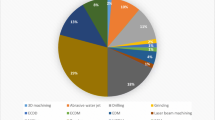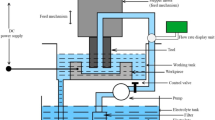Abstract
Optimization of machining processes plays a key role in meeting the demands for high precision and productivity. The primary challenge for machining process optimization often stems from the fact that the procedure is typically highly constrained and highly non-linear, involving mixed-integer-discrete-continuous design variables. Additionally, machining process models are likely discontinuous, non-explicit, or not analytically differentiable with the design variables. Traditional non-linear optimization techniques are mostly gradient-based, posing many limitations upon application to today’s complex machining models. Genetic Algorithms (GAs) has distinguished itself as a method with the potential for solving highly non-linear, ill-behaved complex machining optimization problems. Unlike traditional optimization techniques, GAs start with a population of different designs and use direct search methods stochastically and deterministically toward optimal and feasible direction. However, GAs still has its own drawbacks when it is applied to machining process optimization, including the lack of efficiency due to its binary representation scheme for continuous design variables, a lack of local fine-tuning capabilities, a lack of a self-adaptation mechanism, and a lack of an effective constraint handling method. A novel and systematic evolutionary algorithm based on GAs is presented in this paper in the areas of problem representation; selection scheme; genetic operators for integer, discrete, and continuous variables; constraint handling method; and population initialization to overcome the underlying drawbacks. The proposed scheme has been applied to two machining problems to demonstrate its superior performance.
Similar content being viewed by others
References
T. Back (1996) Evolutionary Algorithms in Theory and Practice Oxford University Press New York
L. Davis (Eds) (1991) Handbook of Genetic Algorithms Van Nostrand Reinhold New York
J. Y. Dong (1992) ArticleTitleA unified optimization model of a machining process for specified conditions of machined surface and process performance International Journal of Production Research 30 IssueID3 647–663
D. S. Ermer (1972) ArticleTitleOptimization of the constrained machining economics problem by geometric programming ASME Journal of Engineering for Industry 94 1067–1070
D. S. Ermer (1997) ArticleTitleA century of optimizing machining operations, transactions of the ASME Journal of Manufacturing Science and Engineering 119 817–822
D. S. Ermer D. C. Patel (1974) ArticleTitleMaximization of the production rate with constraints by linear programming and sensitivity analysis Proc. NAMRC 2 436–449
L. J. Eshelman J. D. Schaffer (1993) Real-coded genetic algorithm and interval-schemata Morgan Kaufmann Los Altos, CA 187–202
Eskicioglu, H., Nisli, M. S. & Kilic, E. (1985). An application of geometric programming to single-pass turning operation. Proceeding of International MTDR Conference, Birmingham, pp. 149–157
Goldberg, D. E. (1990). Real-coded Genetic Algorithm, Virtual Alphabets and Blocking. University of Illinois at Urbana-Champaign, Technical Report No. 90001, September
B. Gopalakrishnak F. Al-Khayyal (1991) ArticleTitleMachine parameter selection for turning with constraints: An analytical approach based on geometric programming International Journal of Production Research 29 1897–1908
Y. D. Jang (1992) ArticleTitleA unified optimization model of a machining process for specified conditions of machined surface and process performance International Journal of Production Research 30 IssueID3 647–663
N. K. Jha K. Hornik (1995) ArticleTitleIntegrated computer-aided optimal design and finite element analysis of a plain milling cutter Applied. Mathematical. Modelling 19 343–352 Occurrence Handle10.1016/0307-904X(95)00011-8
Ladd, S. R. (1995). Genetic Algorithm in C++. Hungry Minds, Inc
C. W. Lee (2000) Intelligent Modeling and Optimization of Grinding Process Purdue University West Lafayette, IN
C. W. Lee T. Choi Y. C. Shin (2003) ArticleTitleIntelligent model-based optimization of the surface grinding process for heat-treated 4140 steel alloys with aluminium oxide grinding wheels Journal of Manufacturing Science and Engineering–Transactions of the ASME 125 IssueID1 65–76
S. Malkin (1976) ArticleTitleSelection of operating parameters in surface grinding of steels Journal of Engineering for Industry–Transactions of the SAME 98 56–62
Z. Michalewicz (1996) Genetic Algorithm + Data Structure = Evolution Programs Springer-Verlag Berlin Heigdelberg New York
D. A. Milner (1976) ArticleTitleUse of linear programming for machinability data optimization ASME Journal of Mechnical Design 100 286–291
D. T. Phillips C. S. Beightler (1970) ArticleTitleOptimization in toll engineering using geometric programming AIIE Transactions 2 IssueID4 355
H. Schwefel (1981) Numerical Optimization of Computer Models Wiley Chilchester, Wes Sussex, England
John S. Strenkowski Yi-Min Wei (1997) ArticleTitleOptimal selection of tooling and cutting conditions for end milling using microgenetic algorithms Manufacturing Science and Technology 2 253–260
Tsai, P. F. (1986). An Optimization Algorithm and Economic Analysis for a Constrained Machining Model. Ph.D. Dissertation. West Virgina University
A. G. Walvekar B. K. Lamber (1970) ArticleTitleAn application of geometric programming to machining variable selection International Journal of Production Research 8 241–245
X. M. Wen A. O. O. Tay A. Y. C. Nee (1992) ArticleTitleMicro-computer-based optimization of the surface grinding process Journal of Materials Processing Technology 29 75–90 Occurrence Handle10.1016/0924-0136(92)90426-S
Wright, A. H. (1991). Genetic algorithm for real parameter optimization. Proceedings of the Foundation of Genetic Algorithms Workshop, Morgan Kaufmann, pp. 205–218
Xiao, G., Malkin, S. & Sanai, K. (1992). Intelligent control of cylindrical plunge grinding. Proceedings of the ACC, Chicago, IL, pp. 391–398
Author information
Authors and Affiliations
Corresponding author
Rights and permissions
About this article
Cite this article
Zhang, J., Liang, S.Y., Yao, J. et al. Evolutionary Optimization of Machining Processes. J Intell Manuf 17, 203–215 (2006). https://doi.org/10.1007/s10845-005-6637-z
Issue Date:
DOI: https://doi.org/10.1007/s10845-005-6637-z




